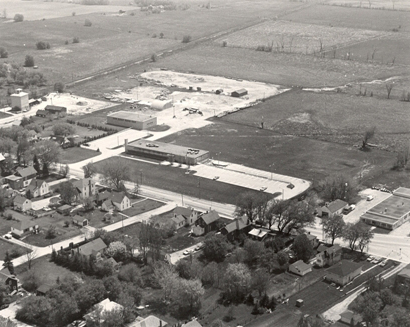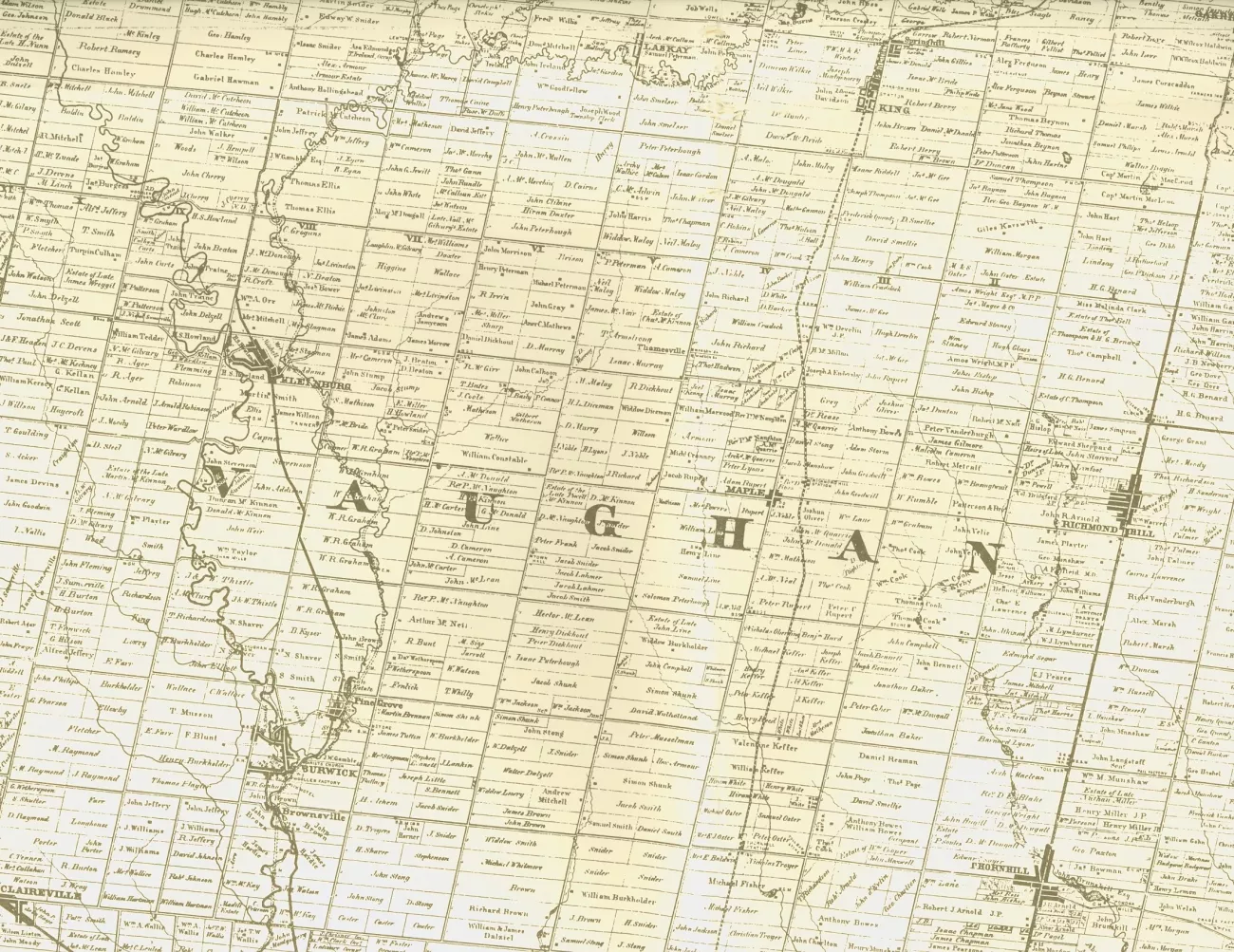Settlement in Vaughan
The lands upon which the City of Vaughan is situated have a rich and varied history. The territory was home to many First Nations, which each had unique histories, traditions, and customs.
Located in the Territory and Treaty 13 lands of the Mississaugas of the Credit First Nation, the City of Vaughan rests upon the traditional territory of the Huron-Wendat and the Haudenosaunee people.

The Huron-Wendat Nation
This historic narrative was kindly provided by a representative of the Huron-Wendat Nation.
The Wendat are ancient people who are part of a great Iroquoian civilization. The Wendat people were traditionally farmers and fishermen-hunter-gatherers. They were also the masters of trade and diplomacy, representing several thousand individuals. They lived in a territory stretching from the Gaspé Peninsula in the Gulf of Saint Lawrence and up along the Saint Lawrence Valley, on both sides of the Saint Lawrence River, all the way to the Great Lakes. According to Wendat traditions and customs, the Wendat people are intimately linked to the Saint Lawrence River and its estuary, the main route of its activities and way of life. The Wendat formed alliances and traded goods with other First Nations among the networks that stretched across the continent.
Huronia, which includes Wendake South, represents a part of the ancestral territory of the Huron-Wendat Nation in Ontario. The ancestral territory extends from Lake Nipissing in the North to Lake Ontario in the South and Île Perrot in the East to around Owen Sound in the West. The territory is marked by many archaeological sites demonstrating the Huron-Wendat Nation's presence in these areas. The archaeological sites are invaluable heritage sites for the Huron-Wendat Nation and represent significant archaeological heritage related to a First Nation in Canada.
Huron-Wendat Nation is one of the oldest First Nation communities in Canada, located on the outskirts of Quebec City (20 km north of the city) on the banks of the Saint-Charles River. Today, the population of the Huron-Wendat Nation is composed of more than 4000 members distributed on-reserve and off-reserve. The Huron-Wendat Nation band council or conseil de la Nation huronne-wendat (CNHW) is headquartered in Wendake.
There is only one Huron-Wendat community, whose ancestral territory is called the Nionwentsïo, which translates to "our beautiful land" in the Wendat language.
Image of the Huron-British Treaty of 1760, courtesy of the Huron-Wendat Nation

The Haudonossee, Missisaugas of the Credit and Early Interactions with Europeans
The first European to make his way through Vaughan was French explorer Etienne Brulé, who travelled across the Humber Trail in 1615. His path was also used by other Frenchmen who came to participate in fur trading with the Huron-Wendat, the Haudenosaunee and the Mississaugas of the Credit.
The French, however, had no interest in colonizing Upper Canada (Ontario) so the lands where Vaughan is situated today did not experience colonial settlement until many years later. In 1763, Britain defeated France in the Seven Years War and took possession of “French Canada.” Yet, there was still no large-scale immigration.
The situation changed 20 years later when Britain was defeated in the American Revolution. Many indigenous peoples had supported the British during this conflict, including the Haudenosaunee leader of the Mohawk Nation, Joseph Brant (Thayendanegea). Those who remained loyal to Britain during the revolution were threatened with persecution by the victorious Americans and the British awarded some followers, including Brant and his tribe, land grants in present-day Canada (Kanata).
In 1787, the head of the Indian Department, Sir John Johnson called a council at the Bay of Quinte to distribute trade goods as a reward to the Mississaugas of the Credit First Nation for their loyalty to the British during the American Revolution. At the Council, Sir Johnson discussed a number of potential land sales along the north shore of Lake Ontario and in particular, they discussed the potential purchase of the “carrying place” from Toronto to Lake Simcoe. Although these discussions were later viewed as the “sale” of Toronto, with the trade goods being wrongly characterized as payment for the Toronto Purchase, as nothing was actually sold at the Council in 1787. The land deed itself was blank and had no description of the land “purchased” by the Crown. Crown administrators soon began to doubt the legality of the original Toronto Purchase Treaty and were concerned that many settlers did not have legal title to their homesteads. To rectify the situation, on August 1, 1805, the Crown purchased 250,830 acres of land for the sum of 10 shillings while the Mississaugas reserved for themselves the right to exclusively fish on Etobicoke Creek.
While land ownership was being challenged by the Mississaugas of the Credit First Nation, British North America (which was divided in 1791 into Upper and Lower Canada) was also under orders to have settlers develop land within the colony. As a result, Upper Canada was divided by Lt. Gov. John Graves Simcoe into 19 counties in 1792 to help encourage settlement.
Simcoe proceeded to lay out a network of roads which would divide the counties into smaller sections called townships. These roads would speed up development and provide settlers with lines of communication and supply.
While basic dirt roads existed beforehand, they were mostly impractical. This situation, paired with the labour-intensive activities of building a cabin, clearing land covered by trees and having no churches, doctors or schools, led one historian to describe life in early Vaughan as “an arduous grind.” In many cases, early settlers brought slaves with them to help with their transition and to help establish a life in Upper Canada.
Pioneer life was difficult and as a result, settlers formed alliances with First Nations peoples, who taught them locations for hunting, fishing and waterways, as well as becoming valuable partners in military conflicts and trading ventures through alliances. Yet despite these hardships, settlers came to the area we recognize as Vaughan today in considerable numbers:
- in 1800, there were 19 men, five women and 30 children
- in 1840, there were 4,300 residents
The first people to arrive were mainly Germans from Pennsylvania, a smaller number of English-descent families and a group of French Royalists. In 1814, migration from the United States was taken over by an influx of immigrants from Britain.
Unlike their predecessors, these individuals were not agriculturalists. This was fortunate as Vaughan required the skills of millers, blacksmiths, merchants and carpenters for the community to be self-sustaining. By 1840, all farmable land in the area was occupied.

Post-Second World War settlement
The population of Vaughan Township changed relatively little from the 1840s (when there were 4,300 residents) to 1935 (when it had a population of 4,873). However, two major changes occurred its ethnic composition. The first was the relocation of the Mississaugas of the Credit First Nation to a new settlement on the Six Nations reserve near the Grand River, a process which began in 1848. Secondly, between 1833 (the British abolition of slavery) and 1861 (the start of the American Civil War), Canada was regarded as a safe haven for those of African descent. Following the end of the war, many people of African descent chose to return to the United States.
Following the Second World War, an influx of immigration changed the landscape again with a population jump of over 15,957 in 1960.

Aerial of Civic Centre in Maple, 1950s
With this population shift, the ethnocultural composition of the area was further transformed with the addition of residents from various nationalities including: Italians, Jews and Eastern Europeans. The influx and immigration of these groups helped to build Vaughan as a multicultural community, with consistent population growth throughout the 1960s-1970s, leading to the establishment of the Town of Vaughan in 1971.
Throughout the 1970s and 1980s, Vaughan embraced the concept of commercial and industrial development, allowing for a steady increase of both businesses and residents within the Town. In 1991, a result of consistent population growth and meeting the population threshold for City Status, Vaughan became the first municipality within York Region to attain City designation, with a population of 111,359. From 1996-2006, Vaughan was recognized as the fastest growing municipality in Canada, having nearly doubled its population since 1991. Over the last decade, Vaughan’s population has continued to increase by more than 28% and is home to people who come from around the world, representing residents who speak 105 different languages.
To this day, the City of Vaughan continues to emerge as an area proudly rooted in its past while looking towards a prosperous future, while meeting the needs of a diverse and multicultural population.

